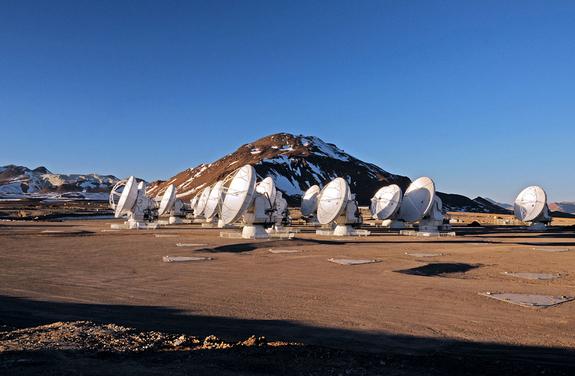Latin America
Related: About this forumALMA – the new high altitude observatory
December 2015
ALMA – the new high altitude observatory
Professor Brian Ellison
The Atacama Large Millimetre/submillimetre Array (ALMA) is the largest and most expensive ground-based telescope ever built. Since it was commissioned, it has begun to revolutionise our understanding of how stars and planetary systems form. Building such a large instrument in the Atacama Desert in Chile, one of the most inhospitable places on Earth, required the ingenuity of hundreds of engineers around the world. Professor Brian Ellison, the UK ALMA project manager, describes some of the challenges that had to be overcome during its construction.
One of the greatest advances in astronomy in the past century has been the advent of sensors that can detect light beyond the visible region of the electromagnetic spectrum. To the unaided eye, the night sky appears as myriad pinpoints of light with large dark spaces between them. This is because the predominant sources of visible light in the universe are stars, which are small when compared with the vast empty spaces between them.
When the sky is observed at other wavelengths, the familiar patterns of stars and constellations are replaced by more complex structures. At wavelengths shorter than the visible region, the Earth’s atmosphere is opaque and observation usually has to be done from space. At longer wavelengths of light, useful observations can be made from the ground in a few narrow infrared bands and more extensively within the radio region. ALMA is by far the most ambitious telescope ever designed to observe these longer wavelengths: an array of 66 twelve-metre diameter dishes (antennas) in the Atacama Desert in Chile, which was completed in 2013 after more than a decade of engineering effort.
ALMA is sensitive to wavebands called the millimetre (mm) and submillimetre (sub-mm) wave and which lie between the far-infrared and radio parts of the spectrum. Within these regions, the whole sky glows with diffuse wispy structures. Most of this light does not come from stars, but rather from cold low-density material that pervades the vast dark expanses of space between them – see Why submillimetre?
This cold material is called the interstellar medium (ISM) and is composed of a mixture of hydrogen gas and micron-sized grit-like grains that astronomers call ‘dust’. It particularly interests astronomers because, over millions of years, it can conglomerate to form new stars and planets; this was also the starting material from which the Sun and Earth were formed. At mm and sub-mm wavelengths, astronomers can look inside nearby regions called molecular clouds where stars appear to be in the process of condensing.
More:
http://www.ingenia.org.uk/Ingenia/Articles/990
Science:
http://www.democraticunderground.com/122844015
longship
(40,416 posts)It resides at fucking 16,500 feet altitude in the Chilean Atacama desert high in the Andes.
Here are some pics:

The super computer which assembles all the data from all those radio telescopes is also at the same summit. It is named "The Correlator". Sounds like a superhero name. At that altitude, it surely is.
Here it is:

Of course, real people have to service these things. At 16,500 feet that is a real problem. One does not just walk up to that altitude with no physical effects.
Ground-based high end astronomy happens at these altitudes, and there are very few locations on our planet which are uniquely suitable for such things. Unfortunately, some ignoraminuses in Hawaii do not understand that.
Fight for science. Build the TMT on Maunakea!